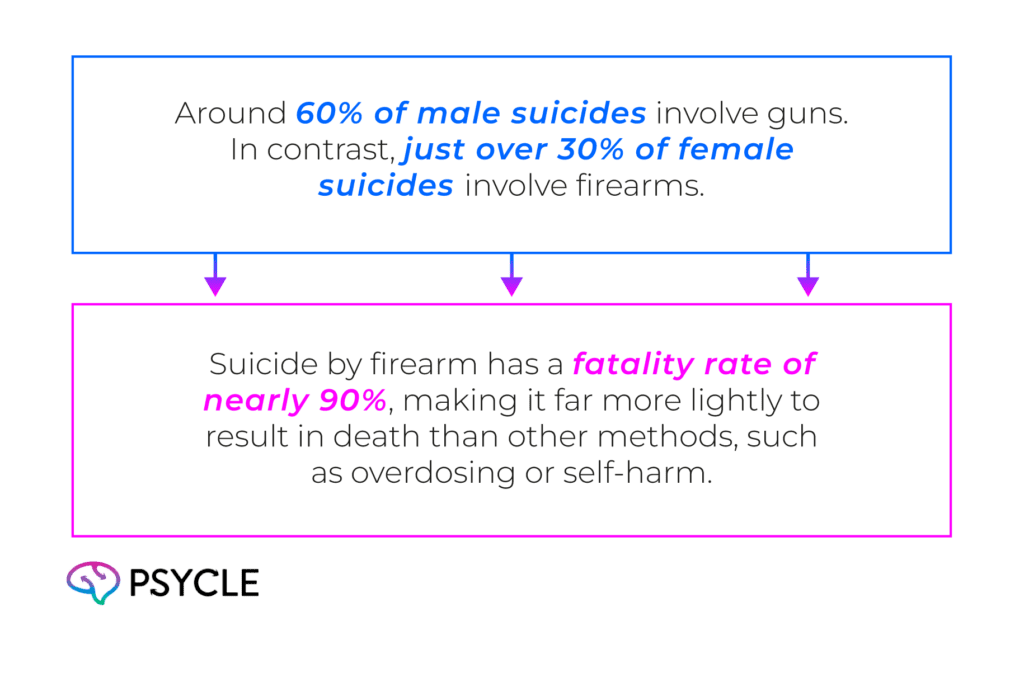Suicide is a critical public health issue in the United States and around the world. Every year, millions of people are impacted by the loss of a loved one to suicide. According to the Centers for Disease Control and Prevention (CDC), one person dies by suicide approximately every 11 minutes in the U.S. alone. While suicide affects people across all demographics, men are disproportionately affected, accounting for a significantly higher percentage of suicide deaths than women.
Key Takeaways
- Men account for nearly 80% of suicide deaths in the U.S.
- Social norms discourage men from expressing vulnerability or seeking help.
- Expectations to succeed and limited emotional outlets increase isolation and distress.
- Men more often use firearms, leading to higher fatality rates.
- Men are more likely to use drugs or alcohol to cope, raising suicide risk.
Suicide Among Men: A Disproportionate Crisis
While both men and women experience suicidal thoughts, the suicide completion rate among men is alarmingly higher. According to CDC data from 2023:
- The suicide rate among men was four times higher than that of women.
- Men make up approximately 50% of the U.S. population, but nearly 80% of all suicide deaths.
- Certain groups are even more at risk: individuals aged 85 and older, and non-Hispanic American Indian and Alaska Native men have some of the highest suicide rates in the country.
The Mental Health Crisis in Men
The high suicide rate in men reflects a complex mix of social, psychological, and cultural factors. Here are some of the key elements that are often involved:
Men Often Suppress Their Emotions
Many boys are taught from a young age that expressing sadness, fear, or vulnerability is a sign of weakness. This ingrained belief often continues into adulthood, leading many men to suppress their emotions rather than seeking support. Bottling up these emotions can increase their weight and detrimentally impact someone’s mental health. Men may also feel alone in their struggles, which can lead to feelings of isolation and further worsen mental health.
Men Are Less Likely to Seek Mental Health Support
The stigma around mental health treatment remains particularly strong for men. According to research by the National Institute of Mental Health, men are significantly less likely to see a therapist or psychiatrist than women, even when struggling with serious symptoms.
This underutilization of mental health services leads to untreated mental health conditions becoming more severe over time. Men may suffer in silence until their distress becomes overwhelming.
The Pressure to Provide and Succeed
Men often face intense societal pressure to succeed professionally, financially, and socially. This “provider role” can create an unsustainable burden, particularly during times of economic hardship, job loss, or family struggles. When men feel they are failing in these roles, they may experience profound shame, isolation, and hopelessness—strong predictors of suicidal thoughts and behaviors.
Lack of Social Support Networks
Unlike women, who often have several emotionally supportive friendships, men may be more likely to struggle with building and maintaining deep social connections. As a result, they may not have someone they can open up to during emotional crises. Loneliness and social isolation are major risk factors for suicide, especially in older men or those living alone.
Why Men Die by Suicide More Often: Use of Lethal Methods
Another key factor contributing to the higher suicide death rate among men is method choice.
Men Are More Likely to Use Violent and Lethal Methods
While women attempt suicide more often, men tend to choose more lethal means. This may reflect social pressure to appear strong, greater impulsivity, and the effects of testosterone on risk-taking.
According to the Collaborative Assessment and Management of Suicidality (CAMS):

Experts refer to this phenomenon as the “gender paradox” of suicide: women are more likely to attempt, but men are more likely to die due to the methods used.
Substance Abuse in Men and Suicide Risk
Higher Rates of Substance Abuse Among Men
Substance use disorders are also more prevalent among men. The National Institute on Drug Abuse reports that men are more likely than women to use illicit drugs, binge drink, and engage in risky substance-related behaviors.
This pattern is often linked to coping mechanisms—men may turn to alcohol or drugs to self-medicate for depression, anxiety, or PTSD, particularly when other forms of emotional expression are discouraged.
The Dangerous Link Between Substance Use and Suicide
Substance use and suicide are closely connected. Many people turn to drugs or alcohol to cope with emotional pain, stress, or mental illness. While it may provide short-term relief, it often leads to long-term problems.
Addiction can heighten feelings of shame, hopelessness, and isolation. As substance use increases, relationships tend to break down, leaving the person even more disconnected. Ongoing use also takes a toll on both physical and emotional health. These struggles often drive further substance use in an attempt to escape the distress—trapping the person in a dangerous cycle that’s hard to break.
Getting Help: Suicide Prevention and Support for Men
If you are a man struggling with suicidal thoughts—or know someone who is—it’s important to know that help is available. Seeking support is not a sign of weakness; it’s a powerful act of courage.
National Resources
- Suicide & Crisis Lifeline (988) – Free and confidential support, available 24/7
- Crisis Text Line – Text HOME to 741741 to connect with a trained counselor.
- Men’s support groups, including organizations like Man Therapy, Movebmber, and HeadsUpGuys, provide community-based peer support, educational resources and therapist directories.
Talking to a friend, family member, or mental health professional can make all the difference and save lives. Innovative treatments, such as ketamine therapy, are also being explored to help reprogram ingrained repetitive thoughts around ending one’s life.
FAQs
I’m Worried My Husband Might Be Suicidal. How Can I Help?
If you’re concerned, trust your instincts—reaching out can make a real difference. Start by gently opening a conversation. You don’t need to solve everything—just being there, listening without judgment, can be incredibly powerful.
Encourage him to talk to a mental health professional, and offer to help him find support if he’s unsure where to begin. If he’s resistant to traditional therapy, you can mention newer treatments like ketamine therapy, which has shown promising results for depression and suicidal thoughts, especially when other treatments haven’t worked.
If there’s an immediate concern about his safety, it’s okay to ask directly if he’s having suicidal thoughts. If he is, take it seriously, and consider reducing access to lethal means like firearms. And remember: you don’t have to carry this alone. Support is available for both of you, and just by being present, you’re already doing something life-saving.

